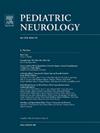Preterm Neonates Exhibit a “Catch-Up” Pattern in Motor Development During the Neonatal Period: A Diffusion Tensor Imaging Study
IF 3.2
3区 医学
Q2 CLINICAL NEUROLOGY
引用次数: 0
Abstract
Background
Preterm infants are at high risk for subsequent neurodevelopmental disability. Early developmental characterization of brain and neurobehavioral function is critical for identifying high-risk infants. This study aimed to elucidate the early evolution of sensorimotor function in preterm neonates by exploring postnatal age-related changes in the brain white matter (WM) and neurobehavioral abilities.
Methods
One hundred eighteen neonates without abnormalities on magnetic resonance imaging were included. Diffusion tensor imaging-derived fractional anisotropy (FA) and neonatal neurobehavioral assessment were separately used to characterize the brain WM microstructure and neurobehavioral development levels. Scatterplots with linear fitting and Pearson correlation were used to investigate the relationships of FA and neurobehavioral scores (active tone and behavior scores) with postnatal age separately for preterm and term neonates. Here, the optical radiation (OR), auditory radiation, corticospinal tract (CST), posterior thalamic radiation (PTR), and thalamus-primary somatosensory cortex were selected as the regions of interest (ROIs).
Results
The preterm FAs in the ROIs were lower than term neonates (all Bonferroni-corrected P < 0.001). Preterm CST FA showed a significantly higher correlation with postnatal age (P = 0.042) than term (r = 0.29 vs 0.08), whereas significantly higher correlations were found in term OR (P = 0.018) and PTR (P = 0.002). Similarly, relatively high and low correlations between active tone (r = 0.48 vs 0.35; P = 0.049 for interactions with a postnatal age ≥14 days and preterm/term group status) and behavioral scores (r = 0.36 vs 0.52; P = 0.030 for interactions of postnatal age and preterm/term group status) were observed in preterm infants.
Conclusions
Although delayed, preterm neonates exhibit a “catch-up” pattern in motor development in the newborn stage.
早产儿在新生儿期运动发育表现出“追赶”模式:一项弥散张量成像研究。
背景:早产儿发生神经发育障碍的风险较高。大脑和神经行为功能的早期发育特征是识别高危婴儿的关键。本研究旨在通过探索出生后脑白质(WM)和神经行为能力的年龄相关变化,阐明早产儿感觉运动功能的早期进化。方法:选取磁共振成像无异常的新生儿118例。采用弥散张量成像衍生分数各向异性(FA)和新生儿神经行为评估分别表征脑WM微结构和神经行为发育水平。采用线性拟合和Pearson相关的散点图分别研究早产儿和足月新生儿FA和神经行为评分(活跃音调和行为评分)与出生后年龄的关系。本研究选择光辐射(OR)、听觉辐射、皮质脊髓束(CST)、丘脑后区辐射(PTR)和丘脑初级体感皮层作为感兴趣区域(roi)。结论:早产儿的运动发育虽然延迟,但在新生儿阶段表现出一种“追赶”模式。
本文章由计算机程序翻译,如有差异,请以英文原文为准。
求助全文
约1分钟内获得全文
求助全文
来源期刊

Pediatric neurology
医学-临床神经学
CiteScore
4.80
自引率
2.60%
发文量
176
审稿时长
78 days
期刊介绍:
Pediatric Neurology publishes timely peer-reviewed clinical and research articles covering all aspects of the developing nervous system.
Pediatric Neurology features up-to-the-minute publication of the latest advances in the diagnosis, management, and treatment of pediatric neurologic disorders. The journal''s editor, E. Steve Roach, in conjunction with the team of Associate Editors, heads an internationally recognized editorial board, ensuring the most authoritative and extensive coverage of the field. Among the topics covered are: epilepsy, mitochondrial diseases, congenital malformations, chromosomopathies, peripheral neuropathies, perinatal and childhood stroke, cerebral palsy, as well as other diseases affecting the developing nervous system.
 求助内容:
求助内容: 应助结果提醒方式:
应助结果提醒方式:


